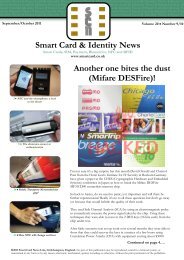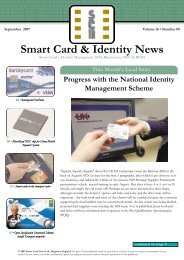Mifare, Oyster and ITSO Cards Hacked Smart Card & Identity News
Mifare, Oyster and ITSO Cards Hacked Smart Card & Identity News
Mifare, Oyster and ITSO Cards Hacked Smart Card & Identity News
You also want an ePaper? Increase the reach of your titles
YUMPU automatically turns print PDFs into web optimized ePapers that Google loves.
In addition to this drawing they have also released further information about the RNG which is a 16 bit<br />
LFSR with characteristic polynomial,<br />
X 16 + X 14 + X 13 + X 11 + 1<br />
The RNG is seeded by the time delay between power on <strong>and</strong> the reception of message data from the<br />
contactless card reader. As they point out this is rather easy to control but they also noticed by intercepting<br />
messages between the card <strong>and</strong> reader that there were already repeats of the r<strong>and</strong>om number used as part of<br />
the authentication protocol <strong>and</strong> which is also input to the main 48 bit LFSR. This main LFSR has 16<br />
feedback taps defined by its characteristic polynomial <strong>and</strong> apparently 20 taps are used for the key stream<br />
output function. <br />
In subsequent discussion the authors have also commented that the exclusive OR input with the secret key<br />
<strong>and</strong> tag ID is not quite as simple as shown in the slide.<br />
When a cryptographic algorithm is widely available one suspects it is only a matter of time before it gets into<br />
the public domain either due to a malevolent employee or by a reverse engineering attack on the chip. This<br />
has happened in many other cases such as in the GSM world <strong>and</strong> the DVD protection algorithm. Public<br />
attacks on the Internet swiftly followed. It is believed that counterfeit <strong>Mifare</strong> chips are already available from<br />
China, the companies concerned would need to have reverse engineered the chip in order to produce such<br />
copies.<br />
Key Exhaustion Attack: The design of cryptographic algorithms is normally based on the assumption that<br />
knowledge of the algorithm is assumed. In other words the algorithm itself is adequately strong <strong>and</strong> that the<br />
security depends on obtaining the secret cryptographic keys. Assuming there is no flaw in the algorithm or its<br />
implementation then the security of the scheme falls down to key exhaustion. Key exhaustion would require<br />
an emulation of the algorithm where all the keys in the key space are tested one by one using matching plain<br />
text <strong>and</strong> cipher text. Alternatively the keys in the key space can be tested one by one against a valid<br />
implementation of the algorithm (e.g. an authentic card). The first condition requires the algorithm to be<br />
known as per the above comments <strong>and</strong> for the key space to be practically realisable.<br />
The <strong>Mifare</strong> algorithm uses a 48 bit key, this gives a total key space of 2^48 or approximately 3 with fourteen<br />
noughts. With today's processing power this would not be deemed adequate by experts in the field. The single<br />
DES algorithm with its 56 bit key has long since been dismissed (it has been practically exhausted in 10<br />
hours) in favour of triple DES with an effective key length of 112 bits (in practice it can be attacked with<br />
slightly less effort but still insurmountable). Today anything much less than a 96 bit key would not be deemed<br />
secure against such an exhaustion attack. An alternative approach would be to take a valid card <strong>and</strong> literally<br />
try each key in turn from the key space. This would require a card select followed by a login process. Just<br />
assuming this could be done in say 10 mS then an attack would take, 2^48 X 10 mS = 89194 years. This<br />
attack is clearly not viable.<br />
Key Vulnerability: The vulnerability of the keys arise from these considerations; 1) An exposure in key<br />
management (including the terminal <strong>and</strong> reader) <strong>and</strong> 2) An exposure to an attack on the card. As mentioned<br />
previously because the keys have to be transmitted to the reader there is an assumption that the terminal can<br />
be trusted. This may be reasonable in some closed schemes such as a mass transit application but in the more<br />
general case this would not be an acceptable assumption. Apart from the obvious invasive attacks on the<br />
chip, we have in recent years, seen very successful attacks on <strong>Smart</strong> <strong><strong>Card</strong>s</strong> by intercepting the power<br />
consumed by the chip whilst undertaking cryptographic operations. Called Differential Power Analysis (DPA)<br />
by their inventor Paul Kocher these techniques were originally applied against the RSA secret keys but later<br />
used against symmetric algorithms such as DES. Such forms of attacks may well be applicable to the Philips<br />
<strong>Mifare</strong> algorithm.<br />
Secure Messaging: In a transaction-based scheme it is st<strong>and</strong>ard practice to protect the messages with some<br />
Cryptographic Check Value (CCV) or digital signature. This ensures the authenticity of the source of the<br />
message <strong>and</strong> that the message has been unchanged in transit from source to destination. This requires that<br />
the <strong>Smart</strong> <strong>Card</strong> is able to both create <strong>and</strong> check such CCVs or digital signatures. Without such security<br />
services being applied it is not easy to resolve disputes <strong>and</strong> the scheme is vulnerable to a wide range of<br />
<strong>Smart</strong> <strong>Card</strong> & <strong>Identity</strong> <strong>News</strong> • January 2008<br />
16
















